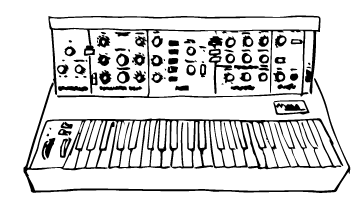Difference between revisions of "Moog Minimoog"
(Building the page) |
|||
| Line 4: | Line 4: | ||
'''Type:''' Monophonic / Subtractive / Analogue | '''Type:''' Monophonic / Subtractive / Analogue | ||
| − | [[File:Moog-minimoog model d.png|none|left]] | + | [[File:Moog-minimoog model d.png|none|left]]One of the most famous & iconic synths ever made, the Minimoog was the first keyboard based portable synthesizer and was immediately successful at launch. Over 14,000 were made between 1970 and 1980, with the Moog company moving locations from Trumansburg to Williamsville over the duration and changing hands several times. |
| + | |||
| + | The instrument was immediately popular at launch with keyboard players of all genres – rock, prog, jazz, and the burgeoning electronic styles – as a more affordable and easier to use version of the preceding modular synthesizers, and introduced the now standard ‘pitch wheel’. The list of verified tracks using the Minimoog is likely to extend to 1,000s long – and that’ll just be the well known songs! | ||
| + | |||
| + | Apart from its powerful three oscillator sound and over-driven filter circuits, one of the keys to its success was the inclusion of a built in keyboard, something not previously seen on portable self-contained synthesizers, such as the EMS VCS 3 (1969). This enabled it to be taken up by electric organ and electric piano players with ease…and it was. | ||
== Archetypal Track == | == Archetypal Track == | ||
Revision as of 14:10, 3 February 2022
Summary
Date: 1972
Type: Monophonic / Subtractive / Analogue
One of the most famous & iconic synths ever made, the Minimoog was the first keyboard based portable synthesizer and was immediately successful at launch. Over 14,000 were made between 1970 and 1980, with the Moog company moving locations from Trumansburg to Williamsville over the duration and changing hands several times.
The instrument was immediately popular at launch with keyboard players of all genres – rock, prog, jazz, and the burgeoning electronic styles – as a more affordable and easier to use version of the preceding modular synthesizers, and introduced the now standard ‘pitch wheel’. The list of verified tracks using the Minimoog is likely to extend to 1,000s long – and that’ll just be the well known songs!
Apart from its powerful three oscillator sound and over-driven filter circuits, one of the keys to its success was the inclusion of a built in keyboard, something not previously seen on portable self-contained synthesizers, such as the EMS VCS 3 (1969). This enabled it to be taken up by electric organ and electric piano players with ease…and it was.
Archetypal Track
Herbie Hancock, ‘Chameleon’ (1973)
The bassline of ‘Chameleon’ shows the Odyssey at it’s funkiest; the filtered bassline driving the groove and the vibe of Herbie Hancock’s classic. There isn’t a better example of the Odyssey doin’ it’s thang!
Notable Artists
Table of all ARP Odyssey Tracks
Notable tracks are highlighted rows
| Artist | Track | Year | Song Part | Notes & Reference | Media |
| ARP Analog Synth Jazz Band | Take The A Train | 1980 | ‘Tap Dancer Getting Shot’ | A TV spot featuring nine ARP synths, introduced by one a presenter in that ‘incredulous’ style, like they’ve never seen a piece of technology before. arpysynth.com |
YouTube |
| Chick Corea | Space Circus | 1974 | Solos | Trading licks with Bill Connors. | YouTube |
| Deep Purple | Space Truckin’ (Live) | 1974 | Solo | Jon Lord lets rip on the Odyssey during this 15 minute classic Deep Purple jam. YouTube |
YouTube |
| Frank Zappa | Inca Roads | 1974 | LFO Synth Effects | This song appears on the album “One Size Fits All.” In the intro, George Duke uses an Odyssey Rev1 to create an LFO based sound effect. arpsynth.com |
YouTube |
| Gary Numan | Cars | 1979 | Synth Lead | "I still like to use the ARP Odyssey because it has the best window-shaking bottom end of any synth." - Gary Numan | YouTube |
| George Duke | Funny Funk | 1974< | Bass/Synth Lead | Album: Feel ”He (Frank Zappa) told me one day, that I should play synthesizers. It was as simple as that! I finally settled on ... an ARP Odyssey. I decided to use an ARP, purely to be different from Jan Hammer, who was playing the Mini Moog, and had a head start on me in the mastery of synthesis. I was really drawn to the possibilities inherent therein. There were some things that were a drag also! Remember, at this time there were no presets or ways of saving patches. Not only that, but you were limited to one note at a time. So overdubbing, a good memory and management system became very important. The year was 1974.” |
YT |
